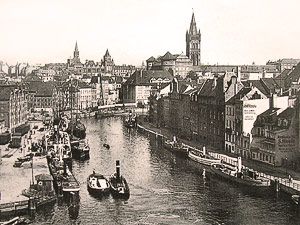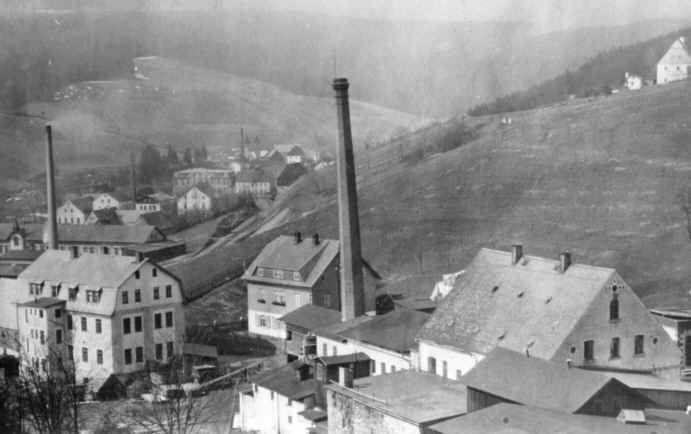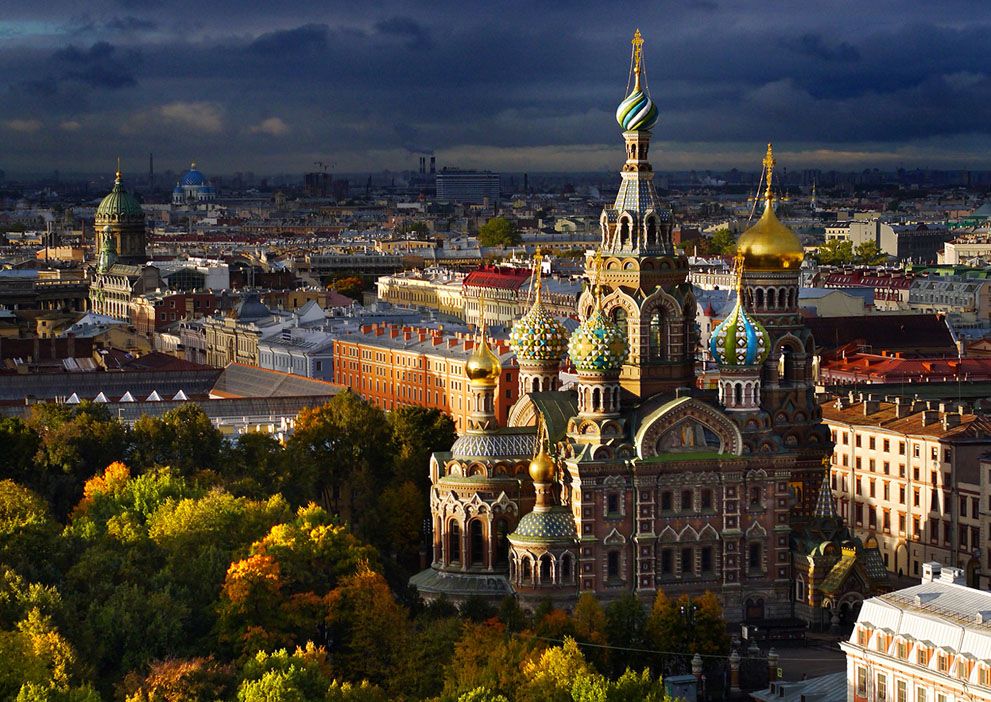The Amber Room – Part Three
That the Amber Room was destroyed during the battle or shortly afterwards by the Red Army as they rampaged through the city is the most prosaic explanation of its fate. This was the conclusion arrived at by English investigative journalists Catherine Scott-Clark and Adrian Levy, after they had undertaken detailed research for their 2004 book on the subject The Amber Room: The Fate of the World’s Greatest Lost Treasure (see bibliography).
Unsurprisingly, not everyone agrees with this conclusion and Scott-Clark and Levy’s book aroused much anger from Russian officials at the time of its publication who claimed that the authors’ hypothesis was completely untrue. Retired General Valentin Varennikov, deputy head of the Soviet General Staff from 1979-84, called the book “propagandist claptrap” and former Russian Minister of Culture Mikhail Shvydkoi accused the authors of “revising history”. Probably the first to dispute the theory that the Amber Room had perished in the flames at Königsberg castle was Anatoly Mikhailovich Kuchumov, the curator of the Tsarskoye Selo museum we met earlier.
In March 1946 the Council of People’s Commissars decided to send Kuchumov to Königsberg on a top secret mission to investigate whether the Amber Room had indeed been destroyed, as Brusov had maintained. On arrival at the castle, Kuchumov found that only the corner of the castle containing the Knights’ Hall remained standing. After searching through the ruins Kuchumov discovered underneath layers of ash “three stone mosaic pictures … that once decorated the Amber Room” and stated that the items were “totally burned and discoloured”. Kuchumov also apparently discovered a hoard of fire-damaged German letters which revealed that the Nazis had planned to get the Amber Room out when Allied bombing in the area began in August 1944.
One of these letters, dated January 12 1945, reported that the Amber Room was being packed ready for transport to safety in a castle in western Saxony (a historical region of eastern Germany). However, as all rail, air and sea routes out of Königsberg were being cut off by the Allies (there were no trains out after January 22) could the Germans have got the heavy crates containing the pieces of the Amber Room out in time?
One theory about how the Amber Room was evacuated is that it was loaded aboard the huge Nazi cruise ship the M.S. Wilhelm Gustloff which left port at Gotenhafen (modern Gdynia in the north of Poland) on January 30,1945. The Wilhelm Gustloff, which was being used as an escape ship by the Germans, was sunk later that day by a Soviet submarine with the tragic loss of an incredible 9,500 lives, the largest loss of life from a shipwreck in maritime history. The wreck of the Wilhelm Gustloff has been visited several times over the years by divers in search of the lost treasure but no trace has ever been found. The question one has to ask is would the Nazis have risked transporting something as valuable as the Amber Room on a ship full to overflowing and heading out into the hazards of the Baltic Sea and Soviet submarines?

Königsberg
In December 1949, Kuchumov was sent back to Königsberg (by then renamed Kaliningrad), to begin another government-sponsored top secret search for the Amber Room, under the pretence that he and his team were searching for oil. With various conflicting tales circulating that the boxes containing the amber panels had been hidden in a sealed subterranean bunker in Königsberg, buried in mines in the Ore Mountains (on the border between the Czech Republic and the federal German state of Saxony), or even smuggled out to America, Kuchumov had his work cut out in finding any trace of the treasured room.
And indeed after a ten-year search Kuchumov and his team had nothing to show for their work. Perhaps a new approach was needed.
On July 6 1958 Soviet newspaper Kaliningradskaya Pravda published a story entitled “The Search Continues for the Missing Amber Room”, the first of a series of three articles about the Soviet search for the Room, which was apparently no longer considered top secret. In these stories journalist Vladimir Dmetriev called for help from the public in locating the lost treasure and loudly proclaimed that the investigations of Professor Brusov in Königsberg in 1945 were unprofessional and error-ridden and his conclusions about the fate of the Amber Room consequently untrustworthy.
However, in their investigations for their book about the Amber Room Catherine Scott-Clark and Adrian Levy carried out extensive research into Vladimir Dmetriev and found no trace of his name in journalistic databases or at Kaliningradskaya Pravda. Their conclusion is that ‘Vladimir Dmetriev’ was probably a pseudonym, most likely for Anatoly Mikhailovich Kuchumov. Nevertheless the sensational article in Kaliningradskaya Pravda had the desired effect and within a couple of days it was being carried by other newspapers, as well as East German magazine Freie Welt, which brought the story to a huge audience in the eastern bloc countries.
As a result of these articles, Amber Room fever spread across central and eastern Europe, thousands of replies pouring in to answer the plea for information from the pen of ‘Vladimir Dmetriev’. These replies came from art historians, former Red Army soldiers, high ranking officials civilians and amateur treasure hunters, some of whom believed they had important information about the Amber Room. The Soviet Union even convinced East Germany of the possibility of recovering the Amber Room, and indeed the files of the Stasi, the East German state security service, contain 180,000 pages related to the Amber Room. However, despite decades of expensive investigations into the lost treasure the Stasi, like their counterparts in the Soviet Union, turned up nothing. Catherine Scott-Clark and Adrian Levy point out that throughout the Stasi’s 26 years of investigation into the Amber Room, not once did the KGB agree to share any intelligence on the subject with the East Germans.
In 1967 the Soviet government founded a special commission to search for the Amber Room, but despite their extensive research and explorations of numerous alleged hiding places for the room, nothing of note was discovered and the Commission was dissolved in 1984. The organization of these numerous unsuccessful searches by Soviet authorities over the last sixty years or so begs the question of what their motives were. Were the Soviets utilizing the theft and possible destruction of the Amber Room by the Germans as a propaganda tool? Or is it possible that the Soviets were covering their own tracks, preserving the myth of the survival of the great lost treasure, having realized early on that it was perhaps its own Red Army who had inadvertently destroyed the Amber Room during the siege of Königsberg early in 1945?
The truth of the latter explanation is indicated by Soviet refusal to share information on their search for the Amber Room with the East Germans and the fact that Kuchumov had also interrogated Paul Feyerabend, on April 2 1946, and Feyerabend had given him the same version of events as he gave Brusov, though Kuchumov chose to ignore him. Perhaps Kuchumov’s guilt about not acting quickly enough to save the Amber Room from the Germans in 1941 was beginning to affect his actions.
The apparent loss of the Amber Room to fire in 1945 has not convinced everyone that there is nothing left to search for. Apart from the Soviet government and the Stasi hundreds of groups and individuals have organized extensive searches for the treasure in mines, lagoons, and hidden bunkers throughout Europe, all without success. Various alternative and conflicting theories as to the location of the Amber Room, some more believable than others, have also emerged over the years. These range from the relatively sane theory that the panels or some of them survived intact, and are still hidden in a bunker in Kaliningrad, to perhaps the most extreme – that Stalin had a second Amber Room built and it was this fake room that the Germans actually stole in 1941. Some researchers believe that the Amber Room survives and is currently in the collection of a shadowy antiquities collector or group with connections either to the Soviet military or to a Nazi cabal of some kind.

Deutschneudorf
In February of 2008 it was sensationally reported that the long search for the Amber Room was finally over when a group of German treasure hunters claimed to have located it along with two tons of Nazi gold in an abandoned copper mine in the Ore Mountains. Spokesman for the group, Heinz-Peter Haustein, the mayor of the nearby village of Deutschneudorf, had been on the trail of the Amber Room for a decade in the region and stated that he was more than 90% sure that he had at last discovered the lost Prussian treasure. Haustein told SPIEGEL ONLINE (see Bibliography) that the chamber his team had located using electromagnetic pulse measurements was probably “part of a labyrinth of storage rooms that the Nazis built here”, and that a friend had told him before he died that “the Nazis sent truckloads and trainloads of valuables to this area throughout the spring of 1945”. Unfortunately, as with many claims of the finding of a long lost treasure, nothing has been heard of Haustein and his fantastic discovery since.
A number of researchers believe that whilst much of the Amber Room was indeed burnt in the fire at Königsberg castle, some pieces survived but were looted by Russian or German soldiers and subsequently became scattered throughout the world. A crucial piece of evidence seemingly in favor of this latter theory came to light in Bremen, northwest Germany in 1997. A German pensioner named Hans Achtermann was arrested in the city after his lawyer was caught trying to sell one of the four jeweled Florentine mosaic panels to an antiquities dealer for $2.5 million. It later emerged that Achtermann was the son of a German officer who had been part of the convoy which brought the amber panels to Königsberg in 1941, though Achtermann claimed he did not know how his father obtained the mosaic.
It was thought that Achtermann’s father may have taken the panel as the convoy was bombed on its way to Königsberg, though there is no reason why he then couldn’t have returned the object when he reached the city. It is perhaps more likely that the officer purloined the treasure during the chaotic evacuation of Koenigsberg in 1945 when perhaps one missing panel would be less likely to be noticed amidst the general panic. Whatever happened during WWII, back in 1997 the German government ordered Hans Achtermann to hand over the treasure, and when he refused, with the prospect of a lengthy legal battle ahead, a local businessman stepped in and reportedly paid $100,000 to Achtermann and his family not to sue to reclaim the panel. A few weeks after the sensational discovery of the panel an ornately inlaid chest of drawers from the Amber Room turned up in Berlin.
An unnamed woman had purchased the chest from Stasi art dealers in the 1970s but had recognized it in a TV report about the Amber Room and turned it over to German authorities. In 2000 officials from Berlin handed over the recovered panel and the chest to Russian President Vladimir Putin in exchange for 101 drawings which had been taken from Karnzow Castle, Brandenburg, by the Red Army in 1945.These masterpieces were part of the Baldin Collection, a group of 364 drawings and paintings looted from Germany and taken to the Soviet Union by a Soviet army captain named Viktor Baldin during World War II.
It is common for most treasure hunting stories to have a curse that affects those involved in discovering or searching for the treasure, and the Amber Room is no exception. It is true that there are one or two suspicious deaths connected with the treasure, beginning with Dr. Alfred Rohde and his wife, who both died in Königsberg in December 1945 during the typhoid epidemic which swept through the city. Their deaths apparently occurred the day before they were to be interrogated by the NKVD (The People’s Commissariat for Internal Affairs) during Soviet investigations into the fate of the Amber Room. Another alleged victim was Yuri Gusev, deputy head of the Main Intelligence Department of Russia’s foreign military intelligence unit, the GRU, who died in a mysterious car crash in Moscow in November 1992. Gusev’s colleagues at the GRU later established that he had in fact been murdered. At the time Gusev had allegedly been giving information to a journalist investigating the whereabouts of the Amber Room, though there seems to be no direct evidence of this.
Something that perhaps shines some light on Gusev’s death is that in August 2010 the body of Major-General Yuri Ivanov, another deputy head of the GNU, washed up on a Turkish beach after he had disappeared whilst on holiday in Syria. The Kremlin stated that Ivanov had died in a tragic swimming accident, though it was suggested by some media sources that he had been on official business and had in the past been employed reviewing military installations in Syria. What is a little suspicious is that the Syrian resort Ivanov was staying at, Latakia, is located relatively close to a strategically important Russian naval facility at the port of Tartus.
More directly connected to the intrigues of the Amber Room is the death of ex-soldier, strawberry farmer and treasure hunter Georg Stein in 1987, who was found naked in a forest near Munich with two kitchen knives in his stomach. Apparently Stein had discovered a radio message giving details of the concealment of the Amber Room after it had supposedly been destroyed, though again there is no physical proof of this.

St. Petersburg
On May 31, 2003, 40 heads of state arrived in St. Petersburg to attend celebrations to mark the 300th anniversary of the city. The centerpiece of these celebrations was the unveiling of a reconstruction of the Amber Room, a painstaking and hugely expensive work 20 years in the making. Modern Russian craftsmen used six tons of amber in the reconstruction of the lost treasure and based their work on surviving fragments of the Room (including the panel discovered in Bremen in 1997), old black and white photographs and one color slide. The new Amber Room was dedicated by Russian President Vladimir Putin and German Chancellor Gerhard Schröder and is now on display at the partially restored Catherine Palace. As to the fate of the original Amber Room, available evidence does indicate that the majority of it perished in the flames at Königsberg castle in 1945. However, the discovery in Bremen in 1997 does suggest that there may be other pieces out there, perhaps smuggled out of Germany in the chaos that followed the Battle of Königsberg, but whether these remnants survive intact as recognizable pieces of the 300-year-old Prussian treasure is another matter.
BIBLIOGRAPHY
Scott-Clark, Catherine; Adrian Levy (2004). The Amber Room: The Untold Story of the Greatest Hoax of the Twentieth Century. London: Atlantic Books.
The Rape of Europa: The Fate of Europe’s Treasures in the Third Reich and the Second World War
Lynn H. Nicholas Vintage Books New York, New York, U.S.A , 1995
Catherine the Great: Portrait of a Woman – Massie, Robert K. Mississauga, ON, Canada: Random House of Canada, Limited, 2011
http://www.forbes.com/forbes-life-magazine/2004/0329/048.html – Mysteries of the Amber Room – Richard Nalley. Forbes Magazine, 03.29.04
http://www.businessweek.com/news/2012-03-27/stasi-s-secret-quest-for-czar-s-lost-amber-room-cost-millions – Stasi’s Secret Quest for Czar’s Amber Room Cost Millions
By Catherine Hickley on March 27, 2012
http://www.spiegel.de/international/germany/digging-for-nazi-treasure-german-treasure-hunters-claim-to-have-found-amber-room-a-536358.html – Digging For Nazi Treasure German Treasure Hunters Claim to Have Found Amber Room By David Crossland
http://www.telegraph.co.uk/news/worldnews/europe/russia/7973346/Top-Russian-spys-body-washes-up-after-swimming-accident.html – Top Russian spy’s body washes up ‘after swimming accident’ By Andrew Osborn, Telegraph online. 31/10/2010




